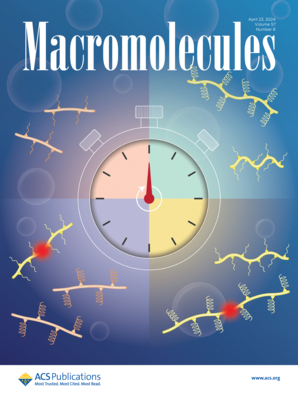Theory of Bauschinger and Some Other Memory Effects in Glassy Polymers
IF 5.1
1区 化学
Q1 POLYMER SCIENCE
引用次数: 0
Abstract
We proposed recently that the strain hardening of glassy polymers is attributed to the increase of free energy barriers for α-relaxation as a consequence of local orientation of Kuhn segments during the course of deformation. As the chains have been significantly oriented at the Kuhn segments scale, the contribution of Kuhn segments orientation to free energy barriers may become large and may then overcompensate the decrease of free energy barriers due to the increasing stress, the latter being responsible for yield and the onset of plastic flow. We show that the slow relaxation of Kuhn segments orientation explains the various memory effects observed in the strain hardening regime and generically named Bauschinger effect. It explains the fact that the stress–strain curve of a second deformation after some waiting time at some point in the strain hardening regime rejoins the reference curve, and that a yield stress is present for this second deformation. Indeed, the degrees of freedom which control the free energy barriers associated with yield relax on the time scale of the experiment, whereas Kuhn segments orientations, that is the degrees of freedom which control the free energy barriers associated with plastic flow in the strain hardening regime, relax slowly. We calculate the evolution of the relaxation time distributions, as well as that of the dominant relaxation time and of the Kuhn segments orientations, during successive deformations (traction–traction, traction-compression, compression-traction, compression–compression). These predictions could be tested experimentally.

求助全文
约1分钟内获得全文
求助全文
来源期刊

Macromolecules
工程技术-高分子科学
CiteScore
9.30
自引率
16.40%
发文量
942
审稿时长
2 months
期刊介绍:
Macromolecules publishes original, fundamental, and impactful research on all aspects of polymer science. Topics of interest include synthesis (e.g., controlled polymerizations, polymerization catalysis, post polymerization modification, new monomer structures and polymer architectures, and polymerization mechanisms/kinetics analysis); phase behavior, thermodynamics, dynamic, and ordering/disordering phenomena (e.g., self-assembly, gelation, crystallization, solution/melt/solid-state characteristics); structure and properties (e.g., mechanical and rheological properties, surface/interfacial characteristics, electronic and transport properties); new state of the art characterization (e.g., spectroscopy, scattering, microscopy, rheology), simulation (e.g., Monte Carlo, molecular dynamics, multi-scale/coarse-grained modeling), and theoretical methods. Renewable/sustainable polymers, polymer networks, responsive polymers, electro-, magneto- and opto-active macromolecules, inorganic polymers, charge-transporting polymers (ion-containing, semiconducting, and conducting), nanostructured polymers, and polymer composites are also of interest. Typical papers published in Macromolecules showcase important and innovative concepts, experimental methods/observations, and theoretical/computational approaches that demonstrate a fundamental advance in the understanding of polymers.
 求助内容:
求助内容: 应助结果提醒方式:
应助结果提醒方式:


